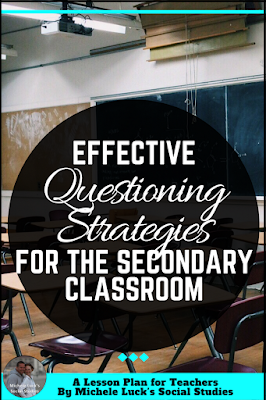Years ago, when I was a student, the basic questions for learning were the the 5 Ws and H. Some teachers just wrote “5WH” on the board, and we knew what was expected for our assignment. We compiled our assessments, essays, and even research papers in the basic format.

In becoming a teacher, I learned that there are reasons behind each of those questions, and there are also better strategies for questioning students in the secondary classroom to help they learn to question for themselves, the greater goal for a Social Studies course!
Teaching requires the use of effective questioning skills. If you are only making statements in your classroom, not only are you limiting your students understanding and engagement, but you are stifling their opportunity for true learning.
So, how do you question effectively?
Start with these basic definitions and descriptions.
- Basic Fact Questions – These information-seeking questions will help students see the layout of the topic of study. They also set the foundation for the questions to follow.
- What do you see?
- Who is involved?
- What are they doing?
- Where is this happening?
- When is this taking place?
- Explanatory Questions – Answering essential questions and focusing on on the big picture is the goal for most history courses. These questions guide your students to that level of learning.
- Why is this taking place?
- How is the event occurring?
- Reactive Questions – Teaching empathy and how to see life through multiple perspectives can be the most valuable lesson your students will learn. Using reactive questions can also be useful in keeping students engaged and helping them find the connections they need to make history or current events relevant to their own lives or futures.
- How do you think they felt…?
- How would you feel if…?
- Imaginative Questions – Helping students think outside of the box is key to their unlocking the tools to the future. Allowing imagination in the classroom also helps students weigh the relativity of the information and to find greater value in it for themselves.
- What do you think happened next?
- How could this problem be solved?
- Challenge Questions – Encouraging students to take the information they have learned even further through investigation or analysis can help them learn the life lesson of the value of inquiry. In our modern world of quick technology-based resources, learning to inquire for clarity or validation will be key for student success. It will also strengthen their confidence as learners, preparing them with the tools they need to justify their positions and points in all walks of life.
- How can we verify this information?
- What sources will provide us greater understanding?
And once you have the questions developed for each lesson, deliver them in a spiral method.
- Start with the obvious to engage all students.
- Build up slowly to develop understanding.
- Add depth to push for critical thinking.
- Wrap up for all student inclusion.
- Review to help foster retention.
While getting into the habit of questioning in your classes can be a challenge at first, it will become second nature to you in no time and it will make you a much more effective teacher. More importantly, it will make your students much more effective learners!

Happy Teaching!